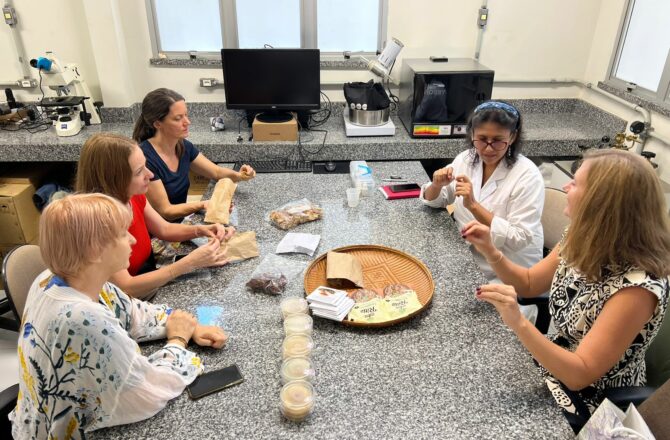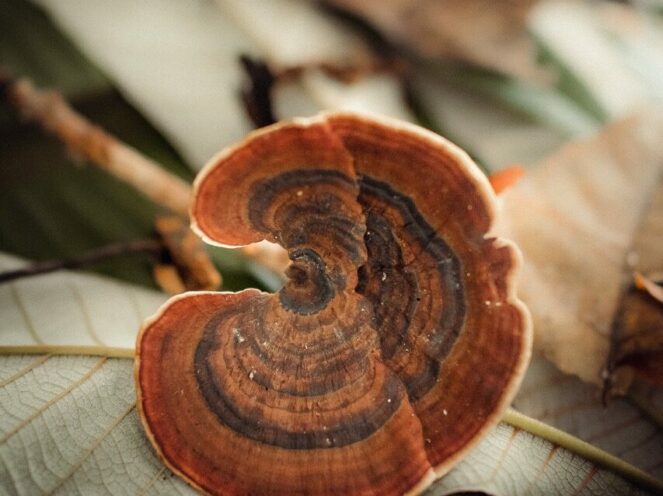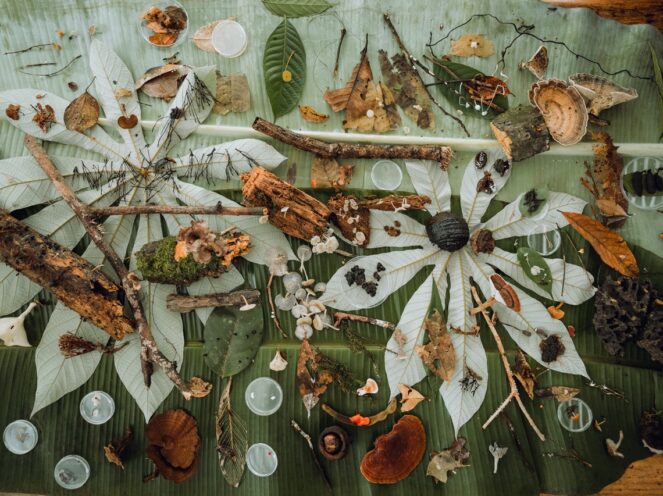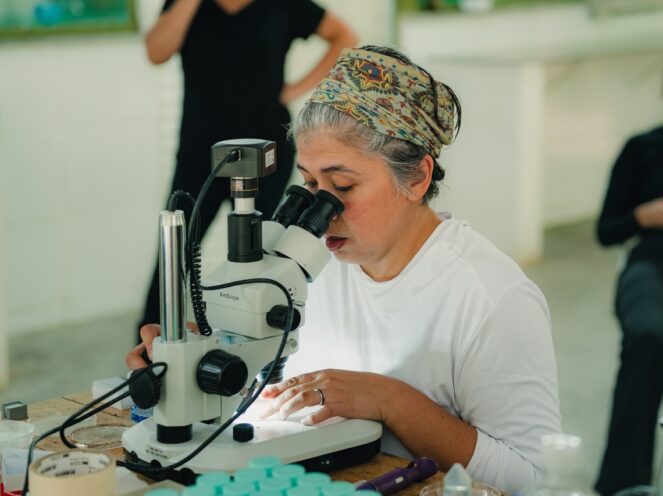
Gabriela Devaud
Fungi Cosmology aims to enable challenging collaboration and foster interdisciplinary innovation. The research project involves expeditions, lectures, workshops, presentations, and seminars. It is a territorial research program between art and science, researching Manaus, Tierra del Fuego, and the Alps.
The first field research destination was Brazil. Participants visited the Amazon, with a field trip to Manaus City, Ecological Reserves, and Cuieiras River, ended the Brazilian phase of the adventure with a first public appearance in São Paulo. This diverse group of artists, scientists, and curators now united for an exchange to build methodologies and strengthen processes, studies, and possible discoveries to disseminate the importance of the fungi kingdom and its relevance for the planet’s future.
This program is a co-creation between Labverde (Amazon) and Casa-Museu Alberto Baeriswyl (Patagonia). It was shaped together with FoodCulture days and the Artists in Labs program at the Zurich University of the Arts (ZHdK), in collaboration with by Pro-Helvetia and Swissnex in Brazil, and has a partnership with The National Institute of Aonian Research (INPA), Swiss Federal Institute for Forest, Snow and Landscape Research (WSL) and Magallanes University.
– By Gabriela Devaud
Our Arts & Science Program Manager, Gabriela Devaud, shared her experience with the Fungi Cosmology group over the past few weeks.
The team’s first encounter happened in Manaus from 13 to 23 March. I left Rio de Janeiro on Sunday to meet the team and take Irene Hediger from ZHdK and Martina Peter from WSL to planned meetings for the next two days. I was happy to meet them in the morning as they were looking forward to this big adventure that would start in the following days. The anxiety was present, which would soon transform into a peaceful sensation after living a great experience.
On Monday, we were happy to go to the Center for the Integrated Study of Amazonian Biodiversity (CENBAM) from the National Institute of Amazonian Research (INPA)
Dr. Ruby Vargas-Isla presented her research on mushroom cultivation techniques for Amazon’s edible mushrooms. Afterward, we were lucky to meet with different lab leaders at INPA that shared their work and research, where we could already see many possibilities to partner and connect with the industry within Brazil.
Ju Simon and Margaux Schwab joined the next day for meetings, and the exchanges got even richer. Thiago Mota Cardoso from the Anthropology of Life, Ecology and Politics Laboratory at the Universidade Federal da Amazonia (UFAM) gave us a great perspective on agricultural habits around Rio Negro, executed almost exclusively by women. He also shared how projects can be seen or built for this specific part of the world and how globally and locally can be looked at differently.
Jose Ignacio Gomez Corte from the Socio-Environmental Institute (ISA), Forest Products Advisor for Yanomami communities, gave us a practical example of projects with Yanomamis that ensure a sustainable and economic return for the communities.
After these first two days of introduction to fungi research at INPA, I felt even more curious about this new world that would be open to us during the project.
In the evening, all project partners and people involved were at Caxiri restaurant to get to know each other and launch the project's first phase.
Women from the “Boca da Mata” association prepared a degustation of fruits and vegetables from the forest and a fantastic dinner with mushrooms and plants from the Amazon. The vitality of this forest was perfectly translated into five plates of delightful tastes, each one honoring specific indigenous communities.
“Boca da Mata” is an organization of the tribal park, a community in Manaus where many indigenous people live and rely on the city. They cater traditional food and serve dishes to the community. Working with mushrooms provides an essential alternative to illegal mining for young indigenous people.
Labverde, cab-Patagonia, Pro Helvetia, Swissnex in Brazil, INPA (MCTI), and all project partners welcomed everyone to the project!
We started on Wednesday with Dr. Noemia Ishikawa, part of the local team for the field trip and researcher at INPA, explaining Amazon’s edible mushrooms and the lab discoveries for the past years. After having a typical Indigenous meal at a local restaurant, we participated in the lecture of Charles Clement about the history of Amazônia. We talked about how humans domesticated the forest around them, how this impacts biodiversity, and how language can affect nature. It was, for me, a very engaging moment and a dive into the fungi world and its connections.
The following day, the team boarded the Victoria Amazonica boat, where they spent one week researching going up the Cuieiras river. I got the chance to spend the first day with them getting to know the place where the Rio Negro encounters the Rio Solimões and then flow together as Amazon until they reach the Atlantic Ocean. We went through igarapé and observed the abundance of the forest. Later we got the chance to swim in the river and feel energized.
To be a transdisciplinary group means to experience knowledge from different perspectives, so the group got to spend one whole week researching other areas, learning within the specialization of each teammate, sharing visions, and creating authentic connections.
They organized an experiment to see the difference between the air pollution in Manaus city and the forest, preparing two reservoirs, each one open for a few minutes to get the spores in the air, one in the city and the other one in the forest. The result was a lot more life created in the one opened in the forest, with infinitely less dust in the air.
They also had the opportunity to do a two-hour walk in the forest, where they found 103 different species of Fungi, large, small, colorful, invisible, smelly, tasty, soft, disgusting, and bioluminescent.
Margaux Schab from FoodCulture Days shares her experience: “The project suggests a primary methodology to connect through the physical coexistence in the field: to look for each other, to gather, to feel and share, and to meet with researchers of each territory. Harnessing artistic and extra-artistic activities, scientific, explorative, and experimental practices, creating spaces for reflection, studying, sampling, and provoking conversation across disciplines and casual conversation in daily contexts. With all these forms and their diversities, we stimulate agency towards the project to activate, propagate, sporulate, and engage in a living process – like fungi”
After this immersive week, Swissnex in Brazil and Labverde welcomed the team and selected guests from São Paulo’s arts, technology, and innovation scene to a closing event at the city. This life-changing experience of researching in the forest for the past week had a noticeable impact on the group.
This first public appearance allowed the curators, artists, and scientists to share their experiences and insights about the residency while tasting food art created by Murilo Selva, our chef for the night. Experiencing mushrooms through our digestive system was a sensory investigation of the entanglements between food, bodies, and the Amazonian biome.
The event enabled great connections, and the sensory evening brought the transdisciplinary crowd together. Professionals from different specialties and fields discovered how transdisciplinary studies affect how they look at research and how this can be positive and open new possibilities. The evening was rich in connections from the arts to science and business, all interested in discovering more about the way Fungi connect the nature we all are part of.
The first step of this very engaging project came to an end. Still, everyone is looking forward to November, when the second part will happen in Patagonia, Chile, before finishing in Switzerland next year.
Gabriela Devaud













